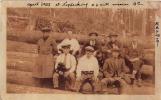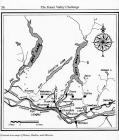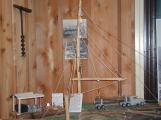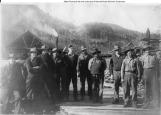1
Tackling The TimbersThe woods surrounding Mission, BC (see map of Canada) have always played a crucial role in the life of the community. Long before Caucasian settlers came to the area, the Sto:lo people used all parts of the Cedar tree as an integral part of their livelihood. When the pioneers came to Mission in the latter half of the nineteenth century, they also turned to the forest for making their homes. In more modern times, our involvement with the timbers of the forests has grown into a multi-million dollar industry.
3
Before the 1880sMany of the first white settlers to venture to the north shore of the Fraser River came from the Hudson Bay Co. in Fort Langley, in search of new timber.
By the 1880s, hand logging for the purpose of clearing land for homesteads and farms had developed into a commercial industry that used oxen logging and spread from Whonnock to Harrison, including Mission City. There were small operations on private farms that ran for the purpose of making railway ties for the Canadian Pacific Railway, which was making its way through BC. Local lumber was in great demand and if men were not laying the ties out on the tracks, they were probably in the woods falling the trees to make the ties.
To the west of Mission there is the Stave River. The Stave is so named because of the abundant supply of spruce trees there that were used for the production of barrel staves for Fort Langley earlier in the century.
To the east of Mission, on Hatzic Prairie, settlers were staking out homesteads. Hatzic Prairie was made up of a number of small communities. These settlers began to log off land for the purpose of creating new homes and farms.
Moises Bouchir was one of the earliest French homesteaders near Durieu on Hatzic Prairie. The Bouchir's had the first "up and down mill" on Hatzic Prairie. This type of mill had one man on top of the log and another below, pulling the saw up and down, and was a rather dangerous operation. Later, these mills were located beside waterways to take advantage of being powered by waterwheels. The Bouchir's mill, located on Bouchir creek, had a waterwheel four feet wide and twenty-two feet in diameter. (1.22 meters x 6.71 meters.)
5
The 1890sIn the early 1890's, a large communal-type settlement was established to the west of Mission along the Stave River by a group of people inspired by the prominent English Socialist John Ruskin.
Dressed lumber and railroad ties became one of the primary industries of this settlement and others in the area. Independent hand loggers, family-run logging operations and sawmills of varying capacity carried out logging there. In 1892/93 George Taggart constructed a sawmill at Silverdale. This mill produced both dressed lumber and railroad ties. Taggart's mill continued to operate until 1896. This was one of the first sawmills to specialize in making a particular product from Mission timber.
Timber for the mills was felled in the woods, the logs were then pulled out by oxen and horses to the edge of Stave River, to be put in the river for transporting. Once in the river, they floated down to the mills at the river mouth, on the Fraser River. Almost all the mills were near water, but only a few mills stayed in one place longer than five years. Once an area was completely logged, the company or family would move on to a new site.
Mission's first rail bridge (1891) was made of local timber products. This was also the first bridge across the lower Fraser and the first connection for the CPR through to Seattle in the United States.
8
The 1900sBy the early part of the century, logging had developed into a booming industry. Smaller operations still worked by hand, using oxen and horses, but the larger operators, who were able to afford the newer options were moving to steam power operations in conjunction with the railroads.
There were four major logging railroads that operated in the Mission and Haney areas. (see map) In the Mission area, Abernethy logging (the largest logging operation in the province, at the time) and Heaps Timber ran two main lines. There were a large number of small logging camps set up along each of these lines.
At about this time the invention of the Steam Donkey enabled logging companies to use steam power, rather than horses to skid (pull) logs from the woods to the railway. Steam Donkeys also allowed them to use steam power to load logs onto railcars. The Steam Donkey was a very welcome addition to the logging industry.
In 1908, Jimmy Michie and Richard Emanuel bought the property along the CPR tracks in Hatzic (on the east side of Mission) and built Mission's first fully steam powered mill.
11
The 1910sThe "Glory Days of Logging", were a mix of improved logging standards and the invention of some very useful techniques. By that time, almost every logging company had to have at least one steam donkey to survive. High lead systems for yarding were tested out and booms were brought in for loading the logs.
Abernethy Lougheed commenced an "A-Frame" logging operation at Stave Lake in 1915, after construction of the Stave Falls Dam. The Western Canada Power Company (WCPC) railway was used to shuttle Abernethy log cars between Stave Lake and the log dumps on the lower Stave River.
Around 1915, Keystone Logging set up operations and started logging east of Stave River. Their main rail line extended north of the river (map from the book "The Fraser Valley Challenge" courtesy of author Arnold McCombs). Much of the present day Keystone Avenue is located on the old rail bed.
Their operation used a new (for the time) development, the High Lead System and a McLean Boom for yarding and skidding. (see photo of high lead model, made by Moe Fossum) They had two locomotives and 22 log cars. With these improvements, they were able to take 30 or more carloads of logs a day to the mills.
12
Japanese logging workers Kanichi Tomita standing on leftApril, 1925
Forest camp, Mission, British Columbia

13
The 1920s and 1930sDuring the 1920s, the first logging trucks began to appear on the main streets of Mission. At the time Peter Bain still used a team of four horses to log (he became a major force as a lumber and railroad tie broker by the late 30's). Later on, Bain was the first man in Mission to use a hard rubber tired truck , while Pete Hammer was the first to use a pneumatic (air filled) tired truck.
Through the 1920s, more and more immigrants were coming to Canada, with hopes of starting a new and better life. Many Europeans (numerous Swedish, Finnish, and Norwegian) as well as the Chinese, East Indians, and Japanese found the town of Mission to be perfect. These men were hard workers and were often immediately hired to help at a logging site.
By the 1930s, almost all of Mission had been or was being logged and most of the small portable mills had disappeared from the Mission logging scene. Logging, with its accompanying sawmills and shake mills, had become Mission's most vital industry, with the Douglas fir going to the local tie mills and the red cedar going to the shingle mills.
An interesting part of Mission's logging history was recovered during research for this exhibit. Due to the relocations of WW2, many Japanese families left Mission and did not return. So, many links to the past have become vague or been lost. We learned that the Japanese were quite involved with the logging industry in the 1920s. Most people associate the early Japanese settlers with the berry industry in Mission, but at one time, there were 2 or 3 logging operations in the Hatzic Prairie area as well as more sawmills on Stave Lake that were owned by Ebbisuzaki and run by his relatives, the Tomitas. Ebbisuzaki's mill was destroyed by fire circa 1929-1931, after which he and his immediate family returned to Japan. The Tomita family stayed in Canada and ended up in Webster's Corners (Maple Ridge) then Delta (closer to Vancouver), they have returned periodically to visit Mission. Their latest visit to Mission was in 2002, when they very kindly shared their photographs with the museum, at the time of initial research for this project.






